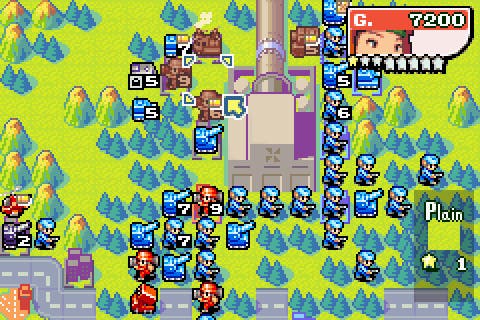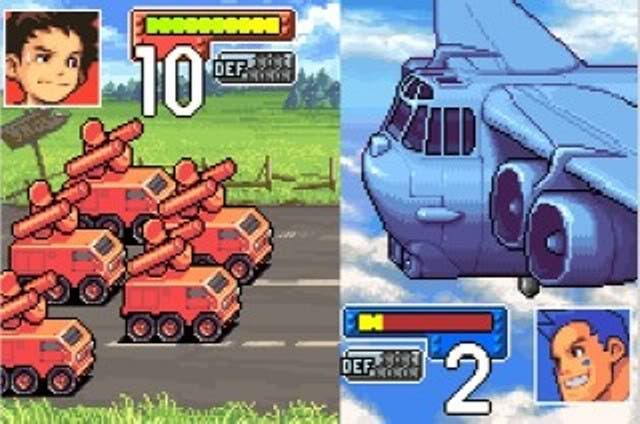Advance Wars retrospective
Lightning strike!
When you're around four or five or maybe even six years old, carpets suddenly become very interesting. They provide the topography for the varied worlds of your imagination: the gentle plains of the moon or Mars, the battlefields of ancient myth. As a kid, I spent an inordinate amount of time carefully getting out my various toys and arranging them on the carpet in the living room. My secret shame - I sensed it even then - was that, once the arranging was taken care of, I couldn't really think of much else to do with them, so I carefully put them away again. That's a classic weekend right there.
Years later, Advance Wars would come to the rescue. Sure, the greatest cart that ever slid into your GBA - give or take WarioWare, of course - is a cold-edged tactics machine if you want it to be. As pure games go, I'd be happy to argue that it's pretty much peerless in its class. You take in the snug little stretch of no-man's land you're faced with, weigh the enemy's congregation of units in your mind, and then decide how to destroy them all as elegantly - or as spectacularly - as you fancy. It's so much more than that, though. It's a game that has never forgotten that it's also a toy. It sticks you back on the carpet with all your old action figures and chipped-paint cars, and it gives you something to use them for.
Advance Wars hardly tries to hide this dual nature. Its maps are products of endless refinement, the strengths and weaknesses of its units are gloriously balanced, the special powers of its commanding officers are perfectly pitched for changing the tide of a battle - and yet look at the way all this stuff is delivered. Look at the cheery spring-sunshine greens and blues and yellows of the landscapes you pick your paths across. Look at the diecast solidity of your tanks and your choppers, at the poseable plastic bulk of the likes of Andy, Max, and Olaf, who chatter away in between missions. I used to tell myself I played through Advance Wars the first few times because I was in love with the tactical possibilities of its tiny sandboxes: what if I took those guys out with air power? What if I was better at using APCs, or smarter when it came to gathering resources in cities? In the years that have followed, though, I've let that charade go. I've played it again and again and again because it's simply so nice to fiddle around with all the bits and pieces - to hear the plasticky ratchetting of a movement arrow as you stretch it across the grass, to see the jello-ish squash of a trooper capturing a city by stomping it down into the ground.

That's not to say it isn't a truly great tactical game, of course. The inputs are simple, the outputs are not, and in learning the connection between the two, you get a primer in why this most calculating of genres is also the most vividly rewarding. There's a pleasure in witnessing how well the gears mesh in Advance Wars, in coming to understand, for example, how each unit is defined in part by the units around it. Strong against this one, weak against that one: I get it! Then you layer on terrain, movement radiuses, resources, CO powers and the personalities and quirks of your enemies. Then add to that the grand campaign in which Advance Wars itself is just a single battle, really - it's the perfect middle child game, poised between the formative strategic excursions of the earlier Famicom Wars titles, and the later experiments - often successful, always interesting - of the GBA and DS instalments that followed. It's a wonderful series in which even the minor missteps are brilliant to play. Advance Wars itself feels like the sweet spot, though: the moment at which a good game found its identity and became a magnificent one.
All of this stuff is only part of the picture though - a crucial part, for sure, but not quite the whole thing. You could argue that the careful-laid strata of the design explains why Advance Wars is one of the greatest turn-based tactical games ever made, but not why it's also a gateway drug - a way into the genre for people who think it's all slide-rules and pincer movements and knowing what Monty's middle name was.
To explain why it's so friendly to newcomers - to explain why so many people pick it up in the first place and are won over before they've even had a chance to realise how accessible it is - we're back to the carpet, I think: back to those toys laid out in neat rows, ready to launch an armada against the cat. It's the units I always come back to in Advance Wars - the look and the feel of the units as much as their actual uses. I know that bombers are powerful glass cannons, devastating against ground forces, useless against a good fleet of jets, but I also know that I just like using them, that their fat bulks look great in the sky where their blue-bottle arrangements of window panes invoke the rumbling, rattling monsters of Catch-22. I know that tanks are a treat not to be wasted and that you shouldn't churn them out in bulk while you're still getting your resource game together, but I can't resist throwing money at them regardless. As well as being tactically significant, they're also wonderfully ownable: neat little boxes of colourful metal, heavy with gears and pipework and tiny little rivets. It's a crime not to make as many as you can afford.

I think this aesthetic chumminess - the sheer 20th century nuts-and-bolts heft of the art - is critical when it comes to untangling why a game with such depths can appeal to such a wide and varied audience. It means that, for once, total newcomers can learn about the joys and terrors of strategy. They can quake at the ominous revving of enemy engines coming from somewhere out there in the fog of war, and they can learn the special genius of a genre that makes you feel powerful and then powerless by turn.
(On that last point, it helps that few games have delivered both halves of the promise with such flair, of course. Get behind a column of medium tanks on the open road, and you'll feel almost shamefully unmatchable as you munch through opposition forces like some kind of Soviet Pac-Man. Enjoy it: minutes later, cowering beneath the onslaught of Green Earth's air force will leave you limping and dishevelled again. Like the best military commanders, Advance Wars' designers truly understand the impact of harassment: that's why they can deliver such glorious jolts of fear when a new unit attacks, or when an enemy captures a factory, a port, an airport.)
The strange sweetness of Advance Wars' visual design also explains the crazy superpositioning trick the game manages to pull with its overall tone. This is a bitter conflict, but it's also good clean fun at the same time. The battles are desperately tense and the fates of nations hang in the balance, but nobody's really getting killed in all those tanks that explode, and nobody has to mourn those infantry soldiers who go flying backwards off the battlefield as if pulled by a stagehand's crook.
Part of the genius of Advance Wars isn't that it ties itself in knots explaining why all the blood that's shed out there in no-man's-land doesn't really stick to the hands of your cheery COs, then. It's that all those years of playing with toys on the carpet has taught its developers that it doesn't really need to explain anything at all. War and play, play and war: where do the metaphors meet when you've got your action figures out in the living room, and you're leading troops on a valiant last push past the skirting board and into the kitchen?









